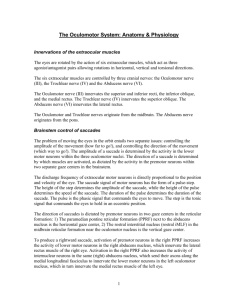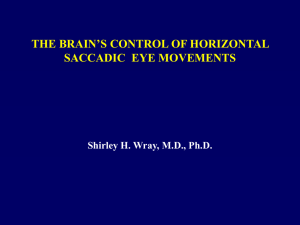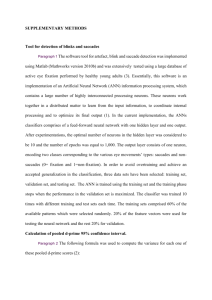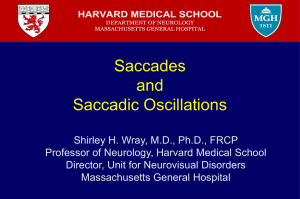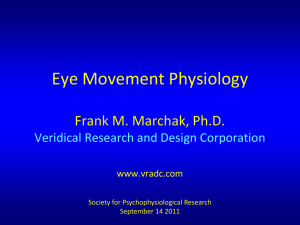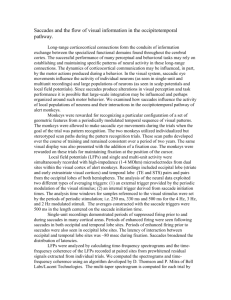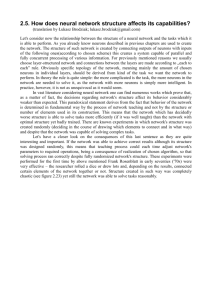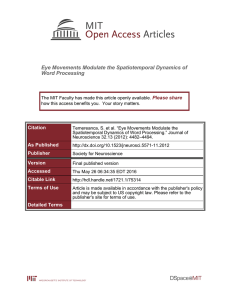Neural Control of Eye Movements
advertisement
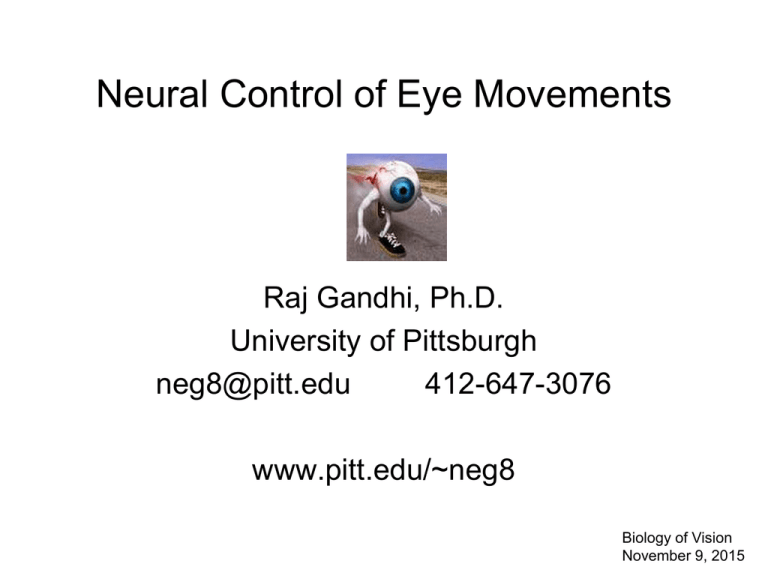
Neural Control of Eye Movements Raj Gandhi, Ph.D. University of Pittsburgh neg8@pitt.edu 412-647-3076 www.pitt.edu/~neg8 Biology of Vision November 9, 2015 References • http://www.tutis.ca/Senses/L11EyeMovements/L11EyeMovements.swf • Principles of Neural Science, Kandel, Schwartz & Jessell (2000) • The Neurology of Eye Movements, Leigh & Zee (1999) • Neuroanatomy through Clinical Cases, Blumenfeld (2002) Types of Eye Movements • • • • • Saccades Vergence Smooth pursuit Vestibulo-ocular reflex (VOR) Optokinetic response/nystagmus (OKR/OKN) http://www.tutis.ca/Senses/L11EyeMovements/L11EyeMovements.swf Extraocular muscles Trochlea Lateral rectus Superior rectus Superior oblique levator Insertion of superior rectus Tendon of superior oblique Insertion of inferior oblique Lateral rectus Inferior rectus trochlea Superior oblique Medial rectus optic nerve Sup. rectus (cut) levator palpebrae (cut) Optic nerve common tendinous ring Inferior rectus optic chiasm Inferior oblique (Modified from Kandel & Schwartz, Principles of Neural Science, 2nd ed., Elsevier Science Publishing, 1985) Six extraocular muscles operate as three agonist/antagonist pairs to move each eye. Lateral / medial recti – horizontal movements Superior / inferior recti – vertical movements; small contribution to torsion Superior oblique / inferior oblique – torsion (cyclorotation of the orbit) and, to a smaller extent, vertical movements http://www.tutis.ca/Senses/L11EyeMovements/L11EyeMovements.swf Control of horizontal eye rotation medial recti lateral rectus oculomotor nerve abducens nerve Oculomotor nuc. Trochlear nuc. Medial longitudinal fasciculus (MLF) Abducens nuc. PPRF (paramedian pontine reticular formation) Modified from Fig. 13.12 of Blumenfeld, Neuroanatomy Through Clinical Cases, Sinauer, 2002. Control of horizontal eye rotation medial recti lateral rectus oculomotor nerve abducens nerve Oculomotor nuc. Trochlear nuc. Medial longitudinal fasciculus (MLF) Effects of lesion of abducens nerve ? Abducens nuc. PPRF (paramedian pontine reticular formation) Modified from Fig. 13.12 of Blumenfeld, Neuroanatomy Through Clinical Cases, Sinauer, 2002. Sixth nerve (abducens) palsy Oculomotor Nuclear Complex bilateral ipsilateral ipsilateral ipsilateral contralateral bilateral contralateral Modified from Fig. 13.3 of Blumenfeld, Neuroanatomy Through Clinical Cases, Sinauer, 2002. Gandhi’s three monkeys Eye Movements: Saccades • Main Sequence Properties Neural Control of Saccades Both cortical and subcortical regions contribute to the control of saccades. In the brainstem, neurons in the pontine reticular formation (Pon RF) and mesencephalic reticular formation (MRF) respectively control the horizontal and vertical/torsional components of saccades. Modified from Kandel et al. Abducens neurons discharge at a tonic rate during fixation, burst during ipsiversive eye movements, and decrease or cease activity during contraversive eye movements. The eye position (during fixation) is directly proportional to the discharge rate of abducens neurons. Key points of saccadic system 1. Direct (velocity) and indirect (neural integrator) pathways http://www.tutis.ca/Senses/L11EyeMovements/L11EyeMovements.swf Omnipause neurons: -- monosynpatically inhibit EBNs -- tonic discharge rate during fixation and cease activity during saccades, functioning in anti-phase with EBNs Visual cortex topography Superior Colliculus (SC) Topographical organization a major subcortical player: SUPERIOR COLLICULUS Superior Colliculus (SC) Topographical organization Superior Colliculus (SC) The SC is a laminar structure separated functionally into superficial, intermediate and deep layers. A target presented at 20-deg to the right of fovea (black dot) will excite middleto-caudal cells in the superficial and intermediate/deep layers of the SC. While the superficial layers respond to presentation of a visual target, the intermediate and deep layers elicit a motor burst with or without a visual response. The sensory response is not limited to visual stimuli, and the motor output is not limited to saccades. Temporal features of saccade-related activity “Visual” burst “Motor” burst Superior Colliculus Optimal Direction Different Amplitudes Optimal Amplitude Different Directions Each neuron in the intermediate layers of the SC discharges during saccades of a restricted amplitude and direction. The cell discharge is weaker for movements of other metrics. The region for which a SC neuron discharges is called the movement field. The topographic map of movement fields in the intermediate and deep layers coincides with the (visual) response fields of the superficial layers. Superior Colliculus Optimal Direction Different Amplitudes Optimal Amplitude Different Directions The # of spikes discharged by this representative neuron is plotted against direction (middle) for saccades of optimal amplitude and against amplitude (left) for saccades in the optimal direction. This cell discharged most vigorously for 10-deg horizontal (rightward) saccades…note recording is in the left SC (right panel). Appreciate that the # of spikes cannot indicate saccade amplitude and direction. It is the location of the neuron on the SC map (left panel) that determines the movement vector. Thus, neurons in the SC use a spatial or place coding scheme. Key points of saccadic system 1. Direct (velocity) and indirect (neural integrator) pathways 2. Spatial to temporal transformation Superior colliculus Population activity If each SC neuron discharges for a restricted range of saccades, then a population of SC cells is active for any given saccade. The executed saccade is a weighted contribution of the movement vectors encoded by each neuron in the ensemble of active neurons. 2 5 10 20 30 40 -60 50 -40 - 20 Scatter plot of the number of boutons per 100 fibers (ordinate) deployed in the PPRF. Dashed vertical lines separate sections that belong to different animals. Small open circles indicate the number of boutons observed in adjacent individual 75 µm sections, whereas large solid circles indicate the average for the animal indicated. The inset is a plot of the average number of boutons deployed in the PPRF per 100 fibers per section (B; ordinate) from each one of the injection sites versus the size of the horizontal component of the characteristic vector of the saccades evoked from the same site ( H; abscissa). Error bars indicate the SEM. The solid line is the linear regression line through the data and obeys the equation displayed. (Moschovakis et al., J Neurosci, 1998). Key points of saccadic system 1. Direct (velocity) and indirect (neural integrator) pathways 2. Spatial to temporal transformation 3. Vector decoding mechanisms in “spatial” structures Brainstem control of saccades 1. 2. 3. 4. 5. 6. SC neurons deliver desired eye movement command. Omnipause neurons (OPNs) that preserve fixation cease their tonic activity. Excitatory burst neurons (EBNs) discharge a high-frequency burst (pulse) to drive the eyes at high velocity. Nucleus prepositus hypoglossi (nph), or the neural integrator, neurons integrate the pulse of EBNs into a tonic response. Extraocular motoneurons (abducens, in this example) sum the outputs of EBNs and neural integrator. The high frequency burst quickly moves the eyes to an eccentric location and the tonic activity maintains the new location. OPNs resume activity to end saccade. • Stimulation of the OPNs during a saccade stops the ongoing movement in midflight. Shortly after stimulation offset, a resumed saccade is executed to bring the eyes near the desired location. The resumed saccade can be generated even when a visual target is not continuously illuminated. This interrupted saccade also demonstrates that saccades are under feedback control. • The feedback is not based on visual or proprioceptive cues. Instead, a corollary discharge of the instantaneous eye movement is used to control the saccadic eye movement. Inactivation of EBN region Barton, E. J. et al. J Neurophysiol 90: 372-386 2003 Copyright ©2003 The American Physiological Society Feedback control Key points of saccadic system 1. Direct (velocity) and indirect (neural integrator) pathways 2. Spatial to temporal transformation 3. Vector decoding mechanisms in “spatial” structures 4. Feedback control maintained by corollary discharge, not sensory feedback

